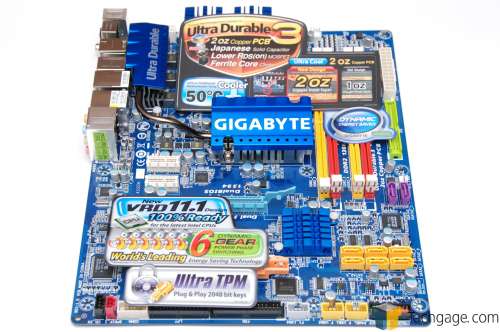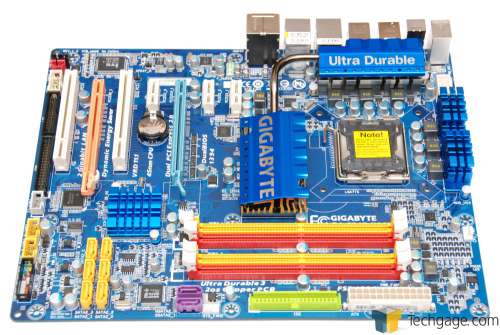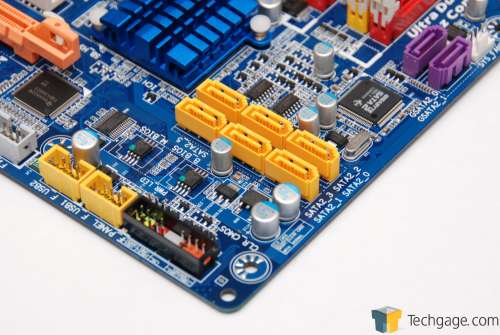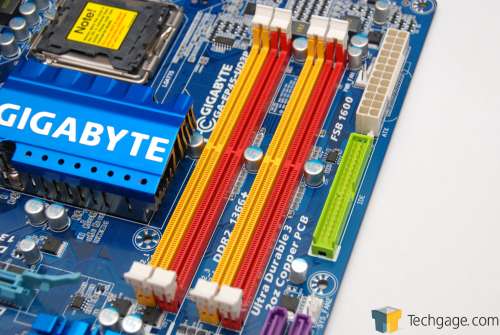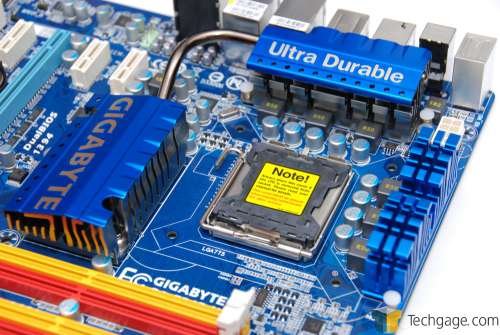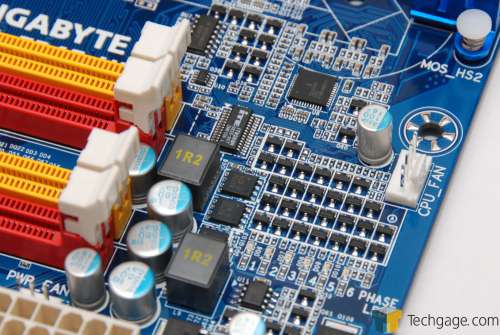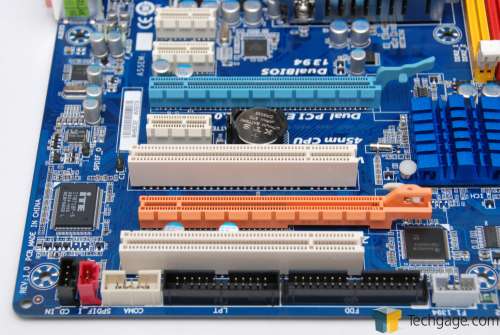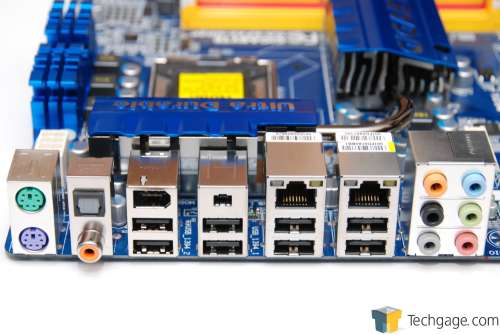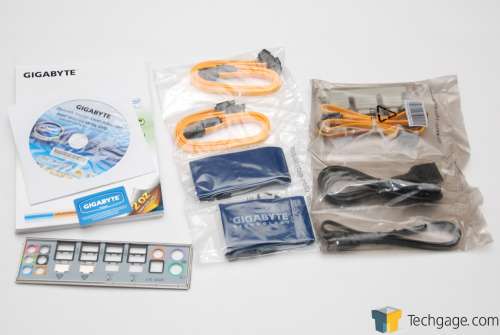- Qualcomm Launches Snapdragon 4 Gen 2 Mobile Platform
- AMD Launches Ryzen PRO 7000 Series Mobile & Desktop Platform
- Intel Launches Sleek Single-Slot Arc Pro A60 Workstation Graphics Card
- NVIDIA Announces Latest Ada Lovelace Additions: GeForce RTX 4060 Ti & RTX 4060
- Maxon Redshift With AMD Radeon GPU Rendering Support Now Available
Gigabyte EP45-UD3P
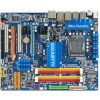
Looking to build a new machine on a budget? Then look no further than choosing Gigabyte’s EP45-UD3P as your choice for motherboard. It may not offer a lot in the area of bling, but it includes a solid design, lots of connectivity (including 8 USB and S-ATA), fantastic overclocking potential and best of all, it comes in at an average price of $115.
Page 1 – Introduction
If there ever was a good time to build a new PC, it would be right now. Of course, that same thought can be said multiple times throughout the year, but given that the PC landscape is going to remain close to what it is now for the next few months, upgrading or building a new rig from scratch right now isn’t going to be regretted in the next month or two.
Things change if you are planning to upgrade to Intel’s upcoming Core i7 (due out second-half of November), but that’s going to be for the crowd who are prepared to splurge on new hardware. Not only does the CPU come into play (at a minimum of ~$300), but the launch motherboards are set to be costly, in addition to the RAM kits. It adds up fast, and I’d expect anyone looking to upgrade to i7 will spend at least $900 – $1,000, which would include the RAM.
For those not yet ready to make that kind of commitment, current-gen offerings are the best bet, and for more than one reason. Not only have recent Intel CPUs been fantastic performers (understatement), prices are now better than ever, with $250 netting you a speedy Quad-Core (Q9300) or $170 for an equally-speedy Dual-Core (E8400). Not to mention that DDR2 prices are at the lowest points in history. Your money is certainly put to good use today, it goes without saying.
For those who thrive on building a fast machine as cheaply as possible, the board we’re looking at today was built for you. At just over $100, it screams value in every-single way, but at first look, you’d never know just how affordable it was. Can its great looks live up to our expectations, despite that budget price tag?
Closer Look
The GA-EP45-UD3P is Gigabyte’s first entry into their Ultra Durable 3 series, which was just announced only a few weeks ago. Ultra Durable is a simple term, but it covers many different aspects of the board’s design, such as efficiency and security. The entire list of “Ultra” features include Cool, Performance, Secure, Power Efficient, Safe, Smart and Speed… all very good things if you ask me.
On UD3, “Ultra Cool” earns its place thanks to the inclusion of additional copper layers inside the PCB. Gigabyte boasts that 2oz of copper is used for these layers, and it serves the purpose of increasing thermals, energy efficiency and better overclocking. Along the same lines, “Ultra Performance” denotes the fact that the board can handle up to DDR2-1366+ speeds, as long as the proper modules are used.
“Power Efficient” is used to denote their usage of their Dynamic Energy Saver feature and also a dynamic six-phase power solution that we’ll talk a bit about shortly. “Ultra Smart” represents their overclocking utility, “Ultra Secure” for their inclusion of TPM (2048-bit keys), “Ultra Safe” for their Dual-BIOS feature and lastly, “Ultra Speed” for the inclusion of LAN port teaming, which essentially combines two individual 1 Gbit/s links and creates a single 2 Gbit/s link.
It’s rather impressive that Gigabyte managed to fit all this into a motherboard that costs roughly $130 without taking advantage of any mail-in-rebates. That’s the kind of value I like to see, and already, it seems like this is going to be one fantastic offering.
In typical Gigabyte fashion, the EP45-UD3P is comprised of a variety of colors, from yellows to reds to blues to purples to greens to *catches breath* – you get the idea. There’s another point of interest in the above photo. Take a look at the fin design to the side of the large Gigabyte-branded heatsink. Due to the reflection from the DIMM slots, it resembles flames. I’m sure this wasn’t done on purpose, but it’s cool nonetheless!
I have no real complaints about the design or layout of the board, although I do wish there were more available fan connectors. This is not unlike any other budget motherboard though, so I guess cuts had to be made somewhere. The BIOS battery also happens to be in an inconvenient location, as it you will have to first remove most any graphics card to reach it.
That’s made worse by the fact that there is no included jumper switch to clear the BIOS easily, so unless you have one hanging around, your only option will be to pull out the battery for a half-hour.
In the below image, you can see the CLR_CMOS jumper I’m speaking about, although it’s a little difficult to see with the ATX chassis connectors directly in front of it. Besides that, this side of the board also features a total of eight S-ATA ports, which again, is more than I’d expect to see on a motherboard that sits in this price-range.
Not surprisingly, to help continue with the “value” theme, DDR2 memory would have been the right choice for this board, and sure enough, Gigabyte agrees. In this image you can also see two of the available fan connectors, which happen to be the only two available other than the CPU fan.
Now here’s a socket you CAN stick your finger into. Well, you know… if the board isn’t powered-on. You can see the six-phase power solution here, and also the 8-pin motherboard connector, which is in a very convenient location, especially if you route your cables through the back of the chassis, which is becoming a popular theme.
Continuing along the lines of the power solution, below you can see the top-right corner of the board which features a variety of LEDs that switch on and off as the different phases are being used.
Where available ports are concerned, we have three PCI-E 1x, although I’m unsure why so many are needed, amongst two legacy PCI ports and also two PCI-E 16x. Since the board uses the P45 chipset, CrossFireX mode is enabled, but if used, the slots operate at 8x each, which will decrease the overall performance of higher-end cards.
The board might carry a great price tag, but you wouldn’t know it by taking a look at the back I/O panel. Of the slew of connectors here, you’ll find eight USB, two FireWire, two Gigabit LAN, 7.1 channel audio as well as S/PDIF outputs and also dual PS/2 ports for legacy keyboards and mice.
Finally, everything needed to get up and running is included cables-wise, including S-ATA, Floppy and IDE. Also included is an additional panel that you can install in one of your spare ports that will open up eSATA functionality.
Overall, I have not a single complaint about this board that can be warranted given its price-tag. Judging by the board and accessories alone, the EP45-UD3P looks to be one fantastic offering. How about the BIOS? Read up on it next.
Support our efforts! With ad revenue at an all-time low for written websites, we're relying more than ever on reader support to help us continue putting so much effort into this type of content. You can support us by becoming a Patron, or by using our Amazon shopping affiliate links listed through our articles. Thanks for your support!




